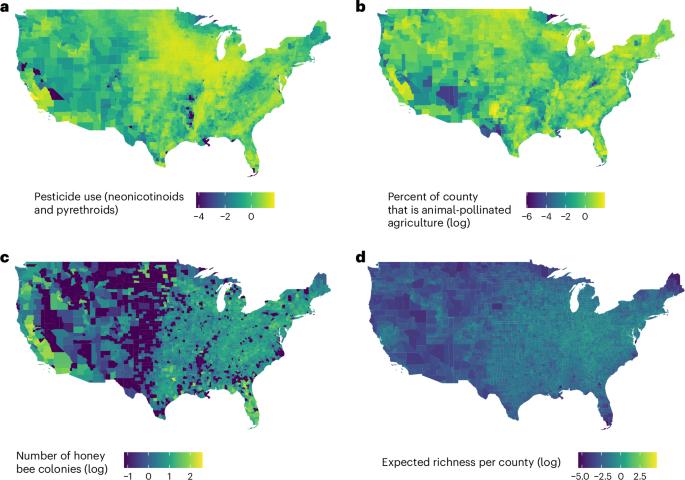Impact of pesticide use on wild bee distributions across the United States
IF 27.1
1区 环境科学与生态学
Q1 ENVIRONMENTAL SCIENCES
引用次数: 0
Abstract
The decline of many wild bee species has major consequences for pollination in natural and agro-ecosystems. One hypothesized cause of the declines is pesticide use; neonicotinoids and pyrethroids in particular have been shown to have pernicious effects in laboratory and field experiments, and have been linked to population declines in a few focal species. We used aggregated museum records, ecological surveys and community science data from across the contiguous United States, including 178,589 unique observations from 1,081 bee species (33% of species with records in the United States) across six families, to model species occupancy from 1995 to 2015 with linked land use data. While there are numerous causes of bee declines, we discovered that the negative effects of pesticides are widespread; the increase in neonicotinoid and pyrethroid use is a major driver of changes in occupancy across hundreds of wild bee species. In some groups, high pesticide use contributes to a 43.3% decrease in the probability that a species occurs at a site. These results suggest that mechanisms that reduce pesticide use (such as integrative pest management) can potentially facilitate pollination conservation. Bees provide important pollination ecosystem services in agricultural landscapes, but the extent to which they are affected by pesticide use on a continental scale has yet to be explored. This study evaluates the impact of pesticide use on wild bee populations across the contiguous United States.

杀虫剂的使用对全美野生蜜蜂分布的影响
许多野生蜜蜂物种的减少对自然和农业生态系统的授粉产生了重大影响。造成物种减少的一个假定原因是杀虫剂的使用;在实验室和野外实验中,新烟碱类和拟除虫菊酯类杀虫剂被证明具有有害影响,并与一些重点物种的数量减少有关。我们利用来自美国毗连地区的博物馆记录、生态调查和社区科学数据(包括来自六科1081个蜜蜂物种(占美国有记录物种的33%)的178589个独特观测数据),建立了1995年至2015年期间与土地利用数据相关联的物种占有率模型。虽然造成蜜蜂数量减少的原因有很多,但我们发现农药的负面影响非常普遍;新烟碱类和拟除虫菊酯使用量的增加是导致数百种野生蜜蜂栖息地发生变化的主要原因。在一些物种群中,农药的大量使用导致某个物种在某个地点出现的概率下降了43.3%。这些结果表明,减少农药使用的机制(如害虫综合治理)有可能促进授粉保护。蜜蜂在农业景观中提供了重要的授粉生态系统服务,但它们在大陆范围内受农药使用影响的程度还有待探索。本研究评估了杀虫剂的使用对美国毗连地区野生蜜蜂种群的影响。
本文章由计算机程序翻译,如有差异,请以英文原文为准。
求助全文
约1分钟内获得全文
求助全文
来源期刊

Nature Sustainability
Energy-Renewable Energy, Sustainability and the Environment
CiteScore
41.90
自引率
1.10%
发文量
159
期刊介绍:
Nature Sustainability aims to facilitate cross-disciplinary dialogues and bring together research fields that contribute to understanding how we organize our lives in a finite world and the impacts of our actions.
Nature Sustainability will not only publish fundamental research but also significant investigations into policies and solutions for ensuring human well-being now and in the future.Its ultimate goal is to address the greatest challenges of our time.
 求助内容:
求助内容: 应助结果提醒方式:
应助结果提醒方式:


